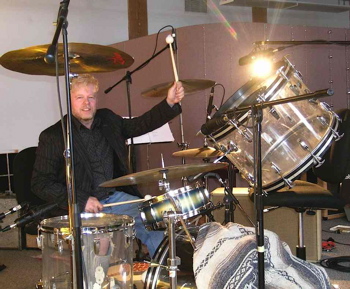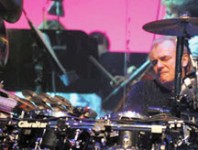Producer/Drummer Anthony J. Resta
 Sonic Exploration With Unusual Recording Methods For Drumset
Sonic Exploration With Unusual Recording Methods For Drumset
Hello, MD readers, my name is Anthony J. Resta. Most of the time I go by AJ or aJaX. This is my first blog for Modern Drummer, and it’s probably a little left of center, mostly because that’s quite often my approach to making what I always hope will be innovative, non-generic, yet marketable recordings. I have several techniques for making unusual moods with drumkits that I’d love to share with you today.
Some people laugh when they see the pictures of my gear, but sonically it’s really interesting and can be useful for a wide variety of results. I’m not sure why I started trying these alternate setups; I think I was just looking for some different moods in the music from the drums and percussion. I heard Tori Amos take an interesting approach on 10cc’s “I’m Not In Love” on a covers album from a few years back, and that track got me thinking. Listening to Tchad Blake’s engineering on Tom Waits records was another catalyst for this “out of the box” thinking.
Here are several of my techniques, followed by links to a few tracks that implement them.
 Technique 1: Use bass drums for toms, and tune them very low. I sometimes play one, two, or three bass drums mounted on office chairs. I play them with my fingers, with the mic preamps cranked up pretty high. I love ribbon mics for recording ambient sounds, as they really capture the darkness. Sometimes I will use timpani mallets or odd combos like one timpani mallet and one brush. There are no rules; I just experiment.
Advertisement
Technique 1: Use bass drums for toms, and tune them very low. I sometimes play one, two, or three bass drums mounted on office chairs. I play them with my fingers, with the mic preamps cranked up pretty high. I love ribbon mics for recording ambient sounds, as they really capture the darkness. Sometimes I will use timpani mallets or odd combos like one timpani mallet and one brush. There are no rules; I just experiment.
Advertisement
Technique 2: Attach other things to your limbs besides sticks. I sometimes tie bells and/or shakers to my wrists or ankles and get some really nice percussion FX. This combined with technique 1 gets some really tribal things going.
Technique 3: Record elements of the “Frankenkit” separately. In other words, do a pass using fingers on the mounted bass drums, a pass of just the hat and hand percussion, and a pass of just the bass drum played with one timpani mallet. It’s fun to leave space on each pass so that you can create these “drumscapes” with just one or two overdub passes. I often go back and choose my favorite parts and edit together three or four takes.
Technique 4: Varispeed-record the kit at a faster tempo than intended. When slowed down to the proper tempo, the drums will sound much lower in pitch. You can do infinite variables of this idea and achieve just as many results. Use a little on the toms, or use a ton on the cymbals—they end up sounding like gongs. Advertisement
Technique 5: Funky furniture and random junk. I have this old leather chair and ottoman from the ’50s, and I mike them up sometimes with more than one microphone and play sticks, brushes, mallets, or combinations of them. The thumping has a really different character than that of drums, but it can add real dimension as an overdub. I have a big red office chair that has a very hollow thump, and I’ve used it many times and have always loved the results. Pieces of sheet metal, stainless steel bowls filled with water, jars of pennies or corn…there is really no end to the possibilities here. I remember seeing a video of Mick Fleetwood soloing on a chair for the track “Second Hand News.” That might have been an early clue for me.
These five simple techniques are just a starting point for your own imagination. Try hitting rocks with plywood, or jumping up and down with big boots on. (Think “We Will Rock You.”) It’s fun and exciting to mix and match all these sonic exercises and make them your own.
Here are links to several audio examples that use the techniques I’ve described. I’d love to hear your ideas too. Thanks for reading.
Very special thanks to audio wizard Karyadi Sutedja.
Anthony J. Resta is a multi-instrumentalist, producer, and composer with nearly twenty years of experience making records with a very diverse client list. For more, go to www.bopnique.com.
Advertisement


